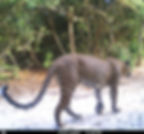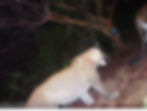
RUHUNA (YALA) NATIONAL PARK BUFFER ZONE
2024 Update: Keeping with the same long-term locations (n = 6), our monitoring more than doubled with 1353 24-hr remote camera periods divided between the Hotels zone (secondary scrub forest adjacent to Block I of Yala National Park; n = 758), Nimalawa Sanctuary (secondary scrub forest separated from Block I by several km of chena (“slash and burn”) cultivation; n = 502) and the chena lands (small forest patch just outside electric fence which separates Block I from chena lands; n = 366).
In terms of observed leopard activity, we are seeing much less multi-year patterns since Covid-19 years (2020-21).
There was an increase in observations in both the Nimalawa Sanctuary and Hotels Zone compared to 2023, but a sharp drop-off was observed in the “chena” landscape. It must be noted that this is only a single remote camera station in 2024, so must be interpreted with caution, however it was surprising to see this location with no leopard observations across the year.
As previously reported, the high RAI for the “chena” location in 2023 was mostly due to a short-term spike in observations of a single individual, who was absent in 2024. The small forest patch within the “chena” lands where this remote camera is located has been increasingly hemmed in since we began monitoring (2019) and this may underlie the reduction in both RAI and the total number of animals using it across time.

This lack of longer-term occupancy seems a feature of this essentially un-protected landscape as the animal detected for the longest period was an adult female who was monitored for 1150 days (~3 years) which represents ~62% of the total monitoring period.
Only 1 other leopard has been monitored here for over 2 years. This suggests that this buffer region does not hold a stable population, but instead shows high turnover and abbreviated occupancy, which contrasts with even the completely un-protected tea estate landscape.
A worthwhile development with the Yala buffer work in 2024 was a collaboration with a group of wildlife photographers who have compiled an extensive record of the leopards within Yala NP Block I.
10 leopards that had been detected both within and outside the park have been cross-matched, beginning a deeper monitoring of the dynamics of the larger population.
In 2025 we will expand our efforts to the western buffer and see if we can attain additional information.
Other wildlife -
2024 detections were of rusty-spotted cat and for the first time since 2021, fishing cat. Although the Jungle cat (Felis chaus) was observed in 2023, no images were obtained in 2024.
The rusty-spotted cat RAIs were considerably lower in 2024 than previous years, even in the “chena” landscape where they are typically more abundant due to an abundance of rodents in these areas
2023 Update: From 2022 to 2023, the Yala Buffer Zone has been monitored in three areas: the Hotels zone, Nimawala Sanctuary, and the outer “chena” lands, accounting for a total of 14 leopards utilising these areas. The Hotels zone is contiguous with Yala National Park Block 1 and is a natural extension for leopards to roam. Consequently, the Hotels zone has had more photo-captures than the other two areas, reinforcing the idea that it is more ideal to sustain leopards. Nimalawa Sanctuary photo captures have decreased compared to previous years. The landscape is scarred by slash and burn agriculture and is undergoing land conversion and habitat fragmentation. Further data must be collected in 2024 to determine longer-term impacts of these influences on leopard land use. The “chena” lands lie between the Hotels zone and Nimawala Sanctuary. They are considered high risk as they are human-dominated and heavily fragmented. This means that leopards–which often have larger ranges than these fragments–are likely to have more conflicts with humans here. We have found that the female leopards in the Yala Buffer Zone tend to settle in close proximity to their natal range, whereas the males are forced to disperse, behaviours which are typical for leopards. However, given the high fragmentation of the "chena" lands, the risk for these dispersing individuals is much higher here. Other mammals, including the vulnerable Mugger crocodile and the endangered elephant were photo captured, indicating the area’s importance for harbouring a full suite of wildlife. The area is risk prone though, with some bears showing scarring from snares. More poachers were detected in this area than in previous years, and they often employ hakkapattas (dynamite shards hidden in bait food) to kill wildlife.
2022 Update: Thus far, we have documented 15 leopards using this buffer area, 3 of which have been seen within the electric fence (in the hotel zone) and in the Nimalawa Sanctuary. Our study has also shown that there is clear overuse of this buffer landscape (including the Nimalawa Sanctuary) by cattle, the high presence of which competes with wild ungulates for food. There is also a risk of cattle passing on disease to wildlife, and since this landscape is directly connected to YNP, it is a cause for concern. Of note, there is evidence of the use of snares and small explosive devices (haka pattas) being used throughout this buffer area and within the Nimalawa Sanctuary for poaching, and eventual consumption, of animals. The extent of these threats on the wildlife here will need to be assessed by continued monitoring. Monitoring will also help determine key locations for increased anti-poaching patrolling to prevent further illegal activities from occurring.
Work in the Ruhuna (Yala) National Park (YNP) Buffer Zone began in June 2018. As the dairy industry in Sri Lanka is being intensified, the risk of cattle and wildlife coming into closer contact is higher, leading to possible competition for space and resources. This potential for wildlife-human conflict scenarios is why the YNP buffer zone is a key research area.
This is a multi-staged project with two overall aims:
To establish the leopard presence and land use in the buffer zone areas of the YNP. This includes determining prey availability, and how this influences the over all leopard population here.
To assess the impact retaliatory killings by cattle herders has on the number of leopard deaths in these border areas. Of import, actual depredation of cattle versus actual depredation will be assessed, and the efficacy of protective cattle pens on wildlife survival in the area.
Additionally, we will perform a comparative study on leopard land use, cattle husbandry, depredation, and farmer perception between the YNP buffer zone and our Central Highland study area. These areas consist of different landscapes, and understanding the differences of land use by farmers and wildlife, and any extant human-leopard conflict, can help us understand the different needs required for the continued conservation of the leopard and wildlife in the area.
Results of Phase I; July 2018 – 2019
The border areas outside of, and adjacent to, the electric fence of YNP Block I, at the Palatupana park entrance was chosen as the study area for Phase I. Starting in July 2018, camera trapping was initiated across 13 set station locations. Due to theft only 9 stations produced any usable data. Interviews with approximately 50 cattle farmers were also conducted, some of whom received protective pens by the Cinnamon Lodge as a separate, private corporate initiative.
Overall, the most predominant species found in this area were domestic bovids. Prey species are also present across the area but their smaller numbers, in comparison with the cattle and buffalo, is a less-than-ideal scenario for a national park buffer zone. This result could hint at a possible change in leopard prey selection (cattle over wild prey), leading to increased, future conflict scenarios with cattle herders. Additionally, the abundance of cattle could mean more competition for grazing vegetation with prey species Both of these factors will be closely monitored and analysed. All four of Sri Lanka’s wild cat species were also detected in the area, albeit at a relatively low frequency, proving the importance of a buffer zone.
Interviews with cattle owners/herders in the YNP buffer study site showed that the primary issue of cattle loss, for them, is theft followed by disease and cattle wandering off. The loss of cattle due to depredation by leopard was the 4th reported cause. However, it is the negative feeling of farmers toward leopards (based on perceived cattle loss by leopard) that poses a significant threat to the leopard population in this shared area.
Phase II; January 2020 – ongoing
This phase was initiated in January 2020 and is still ongoing. Camera trapping stations were set up at 9 locations in the Nimalawa Sanctuary as well as inside the electric fence on the Palatupana side of Block I. Due to the Covid-19 lockdown and restrictions, this study area has remained smaller than originally planned.
Future Direction
The WWCT hopes to expand the current area of study and incorporate the Katagamuwa buffer zone area in this next phase. To assess prey consumption and any potential shift in prey selection, leopard scat analysis will be carried out where possible. To monitor the grazing effects by cattle, vegetation plot enclosures (as seen in work done in the Serengeti National Park, Tanzania) are to be established. Finally, to gain a more robust understanding of land use and population of the leopard, remote camera monitoring will be continued in locations inside and outside Block I, and within all selected buffer areas.
For more detailed accounts of work in this area, please see the attachments below.


